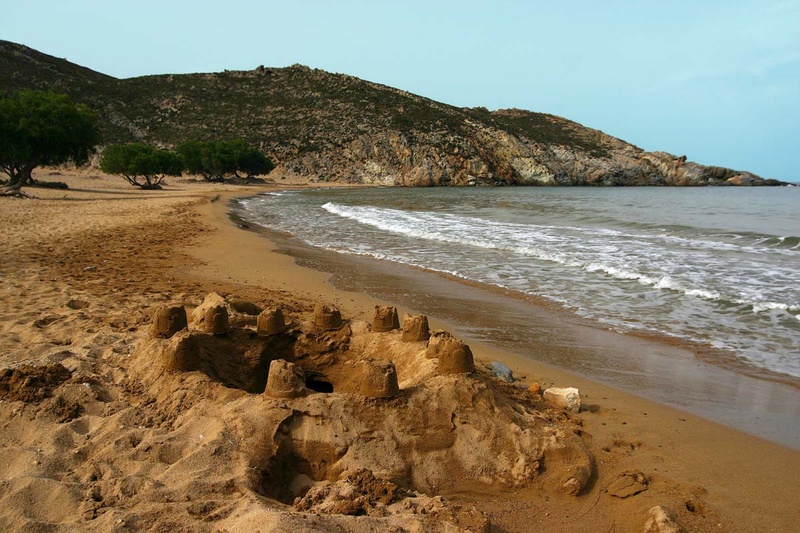Patmos is widely known primarily because the Apostle John wrote the Book of Revelation, the last book of the New Testament, there.
With its whitewashed houses and winding streets, it has a unique natural beauty. The island has stunning beaches, crystal clear waters and steep mountainous terrain. Visitors can hike or bike the island’s hills and valleys, or take a boat trip to explore the coastline and nearby islands.
Patmos is often called the “Jerusalem of the Aegean” because of its spiritual significance. The island’s religious heritage is evident in the many churches and monasteries dedicated to the saints and martyrs of the Christian faith. The most famous church is the Monastery of St. John the Theologian, located in Chora, the capital of the island.
History
During the early Christian era, Patmos became an important center of Christianity, as the Apostle John was exiled there by the Roman Emperor Domitian at the end of the first century AD. John is said to have lived in a cave on the island, where he received the visions he recorded in the book of Revelation. These visions include apocalyptic images and predictions of the end of the world, as well as messages of hope and encouragement for Christians.
During the Byzantine era, Patmos became a place of pilgrimage and a monastery was founded on the island in the 11th century. The monastery, dedicated to Saint John the Theologian, still functions today and is one of the most important religious sites in Greece. Over the centuries, Patmos has been ruled by various powers, including the Byzantine Empire, the Knights of St. John, and the Ottoman Empire. It was incorporated into the Greek state in 1948, after many years of struggle.

Manners and customs
The Sink Ceremony. On the morning of Maundy Thursday, in the central square, the Abbot of the Monastery washes the feet of 12 monks, like Jesus to his disciples during the Last Supper.
The representation of Demobilization. On Good Friday, the epitaphs, after traveling the circuit through local neighborhoods, meet at central points.
The evening of Love. During the Vespers of Love on Easter Day, the Gospel of the Resurrection is heard in many languages, including the Homeric dialect.
The fifteenth of August. The day before the Dormition of the Virgin Mary (August 14), a procession and a litany of her epitaph take place.
Accompanying the image of the Crane
A custom which dates back to 1880 and which takes place on August 15. Some boat owners accompany the image by sea.
On July 26 and 27, the eve and day of the feast of Agios Panteleimon, in Chiliomodi there is a vesper and a feast follows.
On September 24, Saint Thekla, the Holy Apostle, is celebrated, whose small church is built on the island of the same name opposite Agriolivadi. The day before, boatloads of faithful arrive for vespers and baking.
On August 23, the feast of the Dormition of the Virgin, after the liturgy there is a celebration with food, music and dancing.
Types of tourism
Cultural tourism, religious tourism, wine tourism, professional tourism, social tourism, marine tourism, sports tourism, hiking tourism, alternative tourism, ecotourism, even botanical tourism.

Beaches
| With a sandy beach | With stones | With rocks |
| White | Lamp | Crane |
| Greek | Crane meadow | |
| Plain + organized gravel | Stale | |
| Poplars | Twin beaches or Linginos | |
| Kalogira meadow+pebble | To change | |
| Dear | Agia Theofano | |
| Fine sand | Delay | |
| Organized stone | Loukaki | |
| Sapsila | ||
| A few | ||
| Wild meadow | ||
| Kakarine | ||
| Patelia |
Tourist attractions
1. The Monastery of Saint John the Theologian, founded in 1088, is listed as a UNESCO World Heritage Site. In the monastery, in activity and reserved for male monks, the visitor can admire a collection of manuscripts, icons and religious objects.
2. The monasteries of the island, several of which date from the Byzantine era.
3. The Patmos Religious Music Festival which began in 2001. Artists and groups involved in religious music participate and it takes place in front of the Holy Cave of the Apocalypse in late August and early September.

Natural attractions
The Cave of the Apocalypse is a UNESCO World Heritage Site.
sport
Diving, boat rides, jet skiing, boat fishing, water skiing, hiking, running, windsurfing, kitesurfing, etc.
Local recipes and local products
1. Stuffed squid.
2. Stuffed goat.
3. Cuttlefish and squid burgers.
4. Xinomyzythra.
5. Salted fish.
6. Chickpeas.
7. Baked chickpeas with eggplant.
8. Patmos Cheesecake.
9. Meatballs.
10. Octopus pilaf.
11. Almonds – Pears.
12. Forest drink.
13. Swings.
14. Spinach bread or shinopita.
15. Floral water.
16. Apidakia.
17. Adjacent.
18. Svingos (doughnuts).
19. Pouches.


